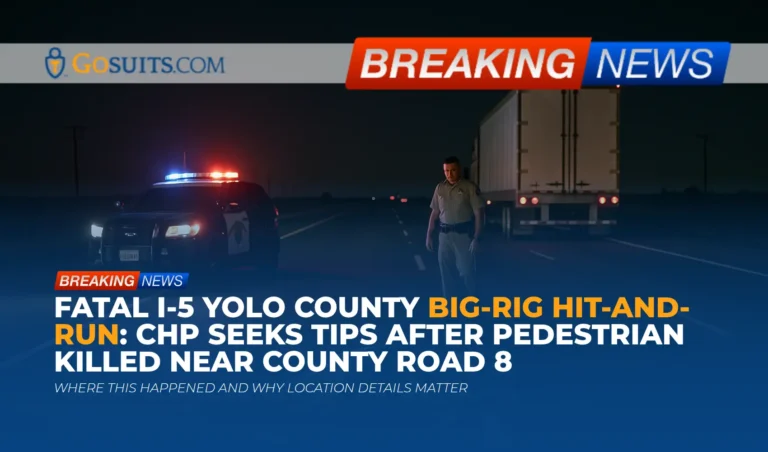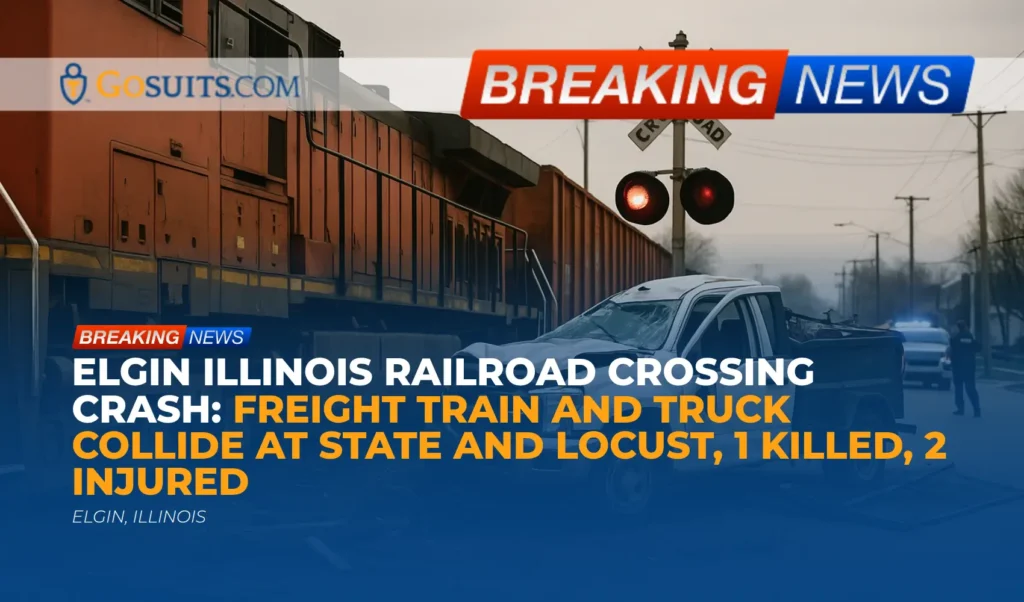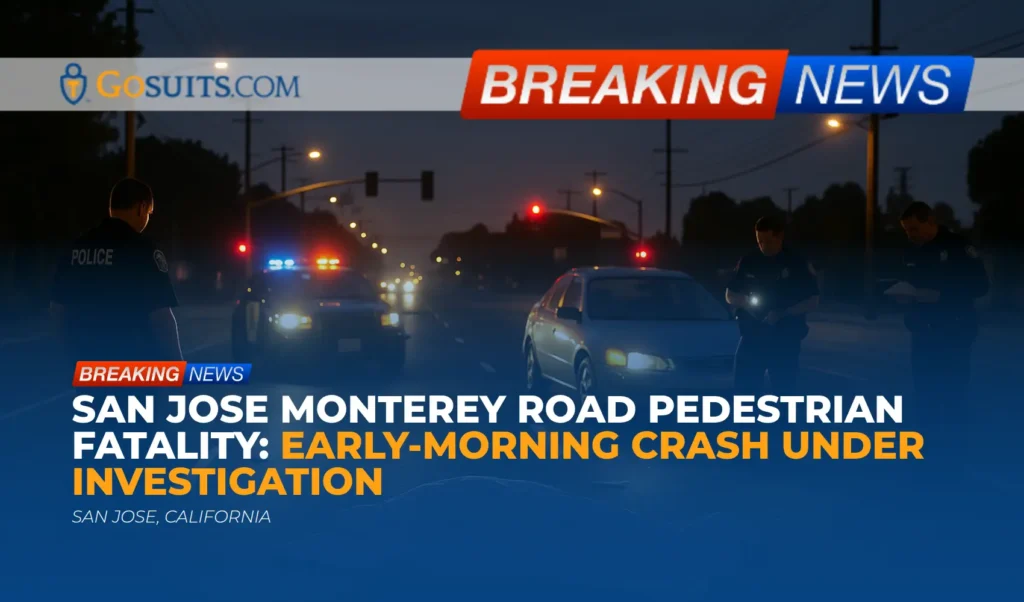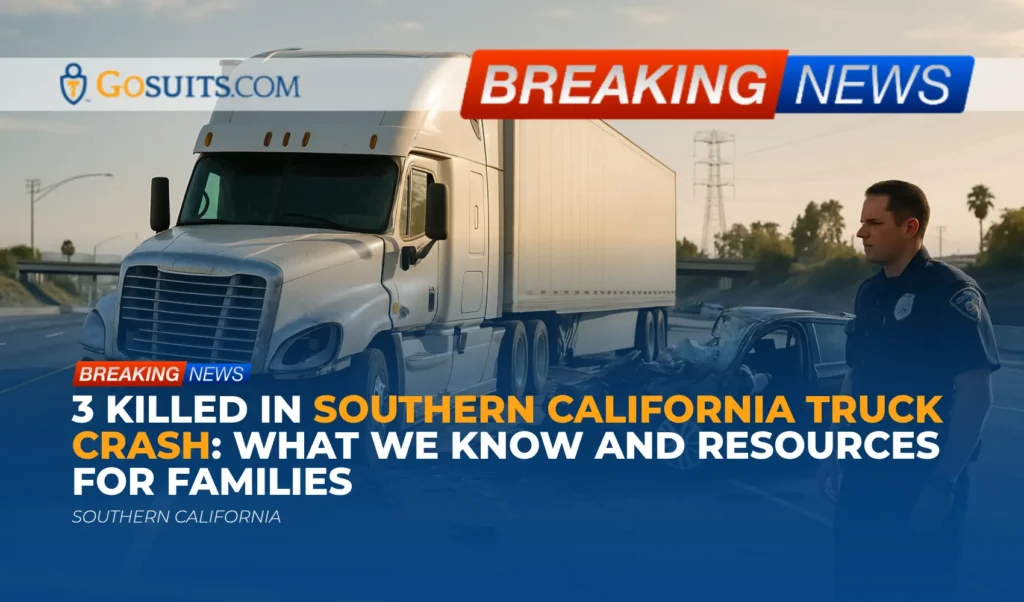- Overview of the I-5 Yolo County Fatal Hit-and-Run Involving a Big Rig
- What We Know So Far
- Where This Happened and Why Location Details Matter
- How CHP Investigates Fatal Highway Collisions and Hit-and-Runs
- Where Families Can Get Official Information and Records
- Safety and Legal Context for Pedestrian Collisions on Highways
- Potential Civil Liability Issues Unique to Big-Rig Hit-and-Run Crashes
- Insurance Pathways After a Hit-and-Run Involving a Pedestrian
- Preserving Evidence Early
- Time Limits in California Civil Claims After a Traffic Fatality
- Steps People Commonly Consider in the First Days
- Support and Victim Services
- Why Acting Promptly Matters After a Fatal Highway Crash
- Commentary from Gosuits Yolo County, California Personal Injury Attorney
Overview of the I-5 Yolo County Fatal Hit-and-Run Involving a Big Rig
Authorities are asking the public for help after a fatal hit-and-run involving a pedestrian and a big rig on Interstate 5 in Yolo County. According to the California Highway Patrol, a 37-year-old man from Seattle, Washington, was struck and killed Tuesday night after reports of a pedestrian running in the lanes. The big rig driver did not remain at the scene. This article aims to clearly summarize the known facts, explain how investigations like this typically proceed, and provide practical guidance for families seeking official information and support during an extremely difficult time.
We recognize that every life lost on the roadway devastates families and communities. If you are reading this after losing someone you care about, please know our thoughts are with you. The details below are intended to be educational and informational, focusing on resources and general legal context without making assumptions about fault or outcomes.
What We Know So Far
Based on information released by the California Highway Patrol:
- Time and date: CHP was dispatched around 8:05 p.m. on a Tuesday night.
- Location: Interstate 5 at County Road 8 in Yolo County, with the big rig traveling southbound from the Dunnigan area.
- Incident description: Witnesses reported a pedestrian running in traffic lanes. Before officers arrived, a big rig struck the pedestrian and left the scene.
- Vehicle description: The big rig was described as a white truck with a cattle guard on the front, and possible damage to the left front headlight assembly.
- Victim: A 37-year-old man from Seattle, Washington. Identity has not been released publicly at this time.
- Investigation: The crash remains under investigation. Witnesses or anyone with information may contact the CHP Woodland Area office at (530) 702-6250.
Because this is an active investigation, some details are naturally limited. Law enforcement typically releases additional information as it is verified.
Where This Happened and Why Location Details Matter
The reported location is Interstate 5 near County Road 8, in Yolo County, southbound direction from Dunnigan. Location details matter because they often determine which patrol office leads the investigation, who maintains any incident-related traffic cameras or pavement sensors, and what agencies might hold useful records. In this region, the California Highway Patrol typically leads freeway collision investigations, with assistance from the county coroner’s office in cases involving fatalities.
Freeways like I-5 are high-speed environments with limited pedestrian access. When a pedestrian is involved in a freeway collision, investigators reconstruct not only the vehicle’s movements but also lighting, sightlines, signage, and any potential contributing environmental conditions. Knowing the precise direction of travel, lane position, and nearby interchanges helps guide canvassing for witnesses and potential video evidence from passing vehicles or nearby facilities.
How CHP Investigates Fatal Highway Collisions and Hit-and-Runs
CHP collision investigations are methodical. While each case is unique, the general steps often include:
- Scene response and preservation: Securing the site, providing emergency care, diverting traffic, and marking evidence like debris fields, tire marks, and vehicle fluid patterns.
- Evidence collection: Taking measurements, photographs, and statements. Investigators may look for parts consistent with a particular truck make or model, including headlight or grill fragments.
- Witness outreach: Requesting information from motorists, nearby businesses, and anyone who saw the collision or the vehicle leaving the area.
- Vehicle identification: Reviewing distinguishing features like a cattle guard, paint transfer, or unique lighting damage to narrow the vehicle list. Commercial trailers may have readable markings or reflectors that inform the search.
- Follow-up with carriers: If the truck can be linked to a carrier, investigators may review maintenance logs, driver hours, and route information consistent with federal rules.
- Coroner coordination: The county coroner determines the cause and manner of death and may retain personal property as part of the investigation.
In fatal hit-and-runs, public tips can be pivotal. Even small details like approximate time, noticeable damage, or company logos can help. If you have any information, the CHP Woodland Area office number provided above is the right starting point for this incident.
Where Families Can Get Official Information and Records
After a fatal collision, families often need multiple records. The offices and forms below are common in California. Availability and timelines vary, and some records will not be released until investigations reach certain stages.
CHP Collision Report
CHP collision reports can typically be requested using form CHP 190 once the report is approved. The CHP explains how to request a collision report on its official website. See “How to Obtain a Copy of a Collision Report” at the California Highway Patrol site: CHP Collision Report Requests. Note that collision reports involving fatalities often take longer to finalize.
Coroner and Autopsy-Related Records
In California, county coroners investigate deaths under specified circumstances, including deaths involving known or suspected vehicle collisions. The scope of a coroner’s duties is outlined in California Government Code section 27491: Gov. Code § 27491. Families may inquire with the county sheriff-coroner’s office about status updates, identification procedures, and the availability of reports. Some materials may be confidential or restricted. Policies and timelines differ by county office.
Death Certificates
Certified copies of death certificates are available through the California Department of Public Health, Vital Records. Information on how to obtain a death certificate is provided by CDPH: CDPH Vital Records. Funeral homes often assist families in requesting these documents.
Towing, Impound, and Personal Property
When a fatality occurs, personal effects may be held by the coroner or released to next of kin after necessary procedures. If a vehicle is impounded as evidence, retrieval and property release typically must be coordinated through law enforcement. It is appropriate to ask the assigned officer or coroner representative about property return procedures.
Safety and Legal Context for Pedestrian Collisions on Highways
Pedestrian fatalities remain a serious public safety concern in California and across the country. National Highway Traffic Safety Administration research indicates that recent years have seen elevated pedestrian fatalities nationwide. NHTSA provides annual Traffic Safety Facts for pedestrian crashes: NHTSA Crash Stats. California’s Office of Traffic Safety also publishes crash rankings and data summaries: California OTS Data.
Freeways are not designed for pedestrian travel. A person on a high-speed highway faces low visibility, high closing speeds, limited refuge, and drivers who may not expect or scan for pedestrians. At night, risk increases due to darkness and glare. Investigators evaluate these factors along with the reported actions of each party and any physical evidence at the scene.
California law requires drivers involved in collisions resulting in injury or death to stop at the scene and fulfill specific duties, including rendering reasonable aid and exchanging information. See California Vehicle Code section 20001: Veh. Code § 20001. The duty to remain at the scene and provide aid is a safety rule designed to protect everyone. In civil cases, violations of safety laws can factor into how liability is assessed under general negligence principles. Every case is fact-specific.
Potential Civil Liability Issues Unique to Big-Rig Hit-and-Run Crashes
Collisions involving large commercial vehicles are complex because multiple parties may be involved and records are often extensive. Depending on the facts determined in the investigation, potential civil liability considerations can include:
- Driver negligence: Whether the driver maintained a proper lookout, adjusted speed to conditions, and took reasonable steps to avoid a collision if time and distance allowed.
- Trucking company responsibility: If the driver was acting within the course and scope of employment, a motor carrier can be responsible under vicarious liability. Additional issues may involve hiring, training, supervision, routing, and scheduling.
- Vehicle inspection and maintenance: Federal rules require commercial motor vehicle inspection, repair, and maintenance, including lights and brakes. See 49 CFR Part 396 overview at the Federal Motor Carrier Safety Administration: FMCSA Part 396.
- Hours-of-service and fatigue: Fatigue can affect reaction times and perception. FMCSA limits driving hours and requires rest periods. See FMCSA’s summary of hours-of-service rules: FMCSA HOS Summary.
- Post-collision conduct: Leaving the scene can affect the availability of immediate aid and later evidence, and may carry civil ramifications. In civil proceedings, factfinders often examine whether a safety statute was violated and how that relates to causation and damages.
When a pedestrian is on a freeway, investigators also assess why the person was there, lighting conditions, visibility, and timing. Civil liability questions are resolved by applying the facts to the law, not by assumptions, and often require careful review of official records and expert analyses.
Insurance Pathways After a Hit-and-Run Involving a Pedestrian
Even before a truck or driver is identified, insurance coverage may be available in certain circumstances. Specific coverage depends on the policies in place and the facts of the incident.

Uninsured Motorist Coverage for Pedestrians
In California, a pedestrian who is struck by a motor vehicle may be eligible for uninsured motorist bodily injury coverage under their own auto policy or a resident relative’s policy, particularly in a hit-and-run where the at-fault vehicle is not identified. The California Department of Insurance provides consumer guidance on uninsured motorist coverage: California Department of Insurance – Uninsured Motorist. Policy language and notice requirements matter, so it is prudent to understand the terms promptly. Before contacting any insurance carrier, it is wise to speak with an attorney; statements to insurers can be used later and may affect coverage and fault determinations.
Medical Payments, Health Insurance, and Funeral Costs
Auto insurance Medical Payments coverage, if purchased, may help with certain medical or funeral expenses regardless of fault. Health insurance can also address medical bills incurred before death. California’s victim compensation program may assist eligible families with funeral and related costs in criminal incidents like hit-and-run, discussed further below.
Commercial Carrier Policies
If a trucking company and driver are identified and found civilly responsible, commercial liability insurance may be implicated. Commercial carriers often have higher policy limits and additional coverage layers, but accessing those benefits usually requires evidence demonstrating fault and causation. Early evidence preservation is important.
Preserving Evidence Early
Evidence can fade quickly, especially on a busy interstate. Timely steps can make a difference in establishing what happened and who may be responsible. Consider these common evidence sources:
- Official records: CHP collision reports, supplemental reports, and coroner findings.
- Scene evidence: Photographs of debris, lane markings, and lighting conditions, if safely obtainable.
- Witness information: Names, phone numbers, and any dashcam footage from passing motorists.
- Commercial vehicle data: For an identified truck, electronic control module data, dashcam video, GPS/telematics, and hours-of-service logs may exist.
- Nearby cameras: Some facilities or vehicles may have captured relevant video. Many systems overwrite data within days.
Attorneys commonly send preservation notices to motor carriers when a truck is identified, instructing that potentially relevant evidence be retained. Acting promptly can reduce the risk of lost data and misunderstandings. Evidence handling should be careful and coordinated to avoid safety issues or interference with official investigations.
Time Limits in California Civil Claims After a Traffic Fatality
California imposes legal deadlines for civil claims. Missing a deadline can forfeit rights, so calendaring is important.
Wrongful Death and Survival Claims
- Wrongful death: California Code of Civil Procedure section 377.60 governs who may bring a wrongful death action. See: CCP § 377.60.
- Survival actions: Claims that the decedent could have pursued if they had lived are addressed in CCP section 377.30. See: CCP § 377.30.
- Statute of limitations: The general limitations period for wrongful death is two years from the date of death under CCP section 335.1. See: CCP § 335.1.
Other deadlines can apply depending on the parties involved and the claims asserted.
Claims Involving Government Entities
If any claim is asserted against a public entity, California’s Government Claims Act typically requires a written claim be presented within six months of the accrual date for claims relating to death or injury. See Government Code section 911.2: Gov. Code § 911.2. Shorter timelines make early evaluation important.
Insurance Notice Requirements
Insurance policies can require prompt notice and cooperation. Uninsured motorist coverage, for example, often has specific notice and proof requirements, especially in hit-and-run situations. Before making statements to any insurer, consider speaking with an attorney so you understand what information is necessary and how it may be used.
Steps People Commonly Consider in the First Days
Each family situation is different. The following are general steps people often consider after a fatal highway collision. These are offered for informational purposes only.
- Get the CHP incident number: Ask the responding CHP area office for the report or incident number to track the case and later request the collision report.
- Confirm coroner procedures: Speak with the county sheriff-coroner’s office about identification, next-of-kin notifications, and the process for obtaining permissible records.
- Request certified death certificates: Coordinate with the funeral home and the California Department of Public Health for needed copies. See CDPH Vital Records.
- Preserve potential evidence: Save photos, videos, and communications. Identify any potential witnesses and record their contact information.
- Check available insurance: Review auto policies for uninsured motorist and Medical Payments coverage. Consider applicable life insurance or accidental death benefits. Before contacting any insurer, speak with an attorney to understand your rights and obligations; what is said to an insurance company can be used later.
- Consider financial and employment documents: If a civil claim is pursued later, records of income, dependents, and household services can be relevant to damages assessments.
- Seek supportive services: California’s victim compensation program may help eligible families with funeral costs and other expenses tied to qualifying criminal incidents like hit-and-run. See California Victim Compensation Board.
Support and Victim Services
Practical and emotional support matters in the aftermath of a sudden loss.
- Victim compensation: The California Victim Compensation Board may provide assistance for funeral and burial, grief counseling, and certain related expenses for eligible claimants in criminal incidents. Visit CalVCB to learn what costs may be covered and how to apply.
- Law enforcement liaison: Keep in contact with the CHP investigator or public information officer assigned to the case for status updates. When you call, have the incident number ready.
- Community resources: Hospitals, chaplain services, and local support organizations can help with grief resources and logistics. Your county’s official websites and public health departments often maintain resource lists.
- Documentation help: Funeral homes and social workers can assist with death certificates, benefits claims, and other paperwork, which can ease administrative burdens.

Why Acting Promptly Matters After a Fatal Highway Crash
The period immediately after a fatal crash is overwhelming. Timely steps can prevent evidence loss, protect rights, and ease administrative burdens. The following points explain why prompt action often matters, without directing anyone to a particular firm.
- Evidence disappears quickly: Commercial vehicle data, dashcam video, and business surveillance footage can be overwritten in days. Prompt evidence preservation requests help keep crucial information from being lost.
- Insurance timelines apply: Insurance policies and state law impose notice and presentation requirements. Meeting these early ensures claims are not denied for technical reasons.
- Government claim deadlines are short: If a public entity is involved, a six-month claim presentation deadline often applies. Early evaluation avoids missed windows.
- Accurate information prevents misunderstandings: Early coordination helps ensure that law enforcement, insurers, and other involved parties have the correct facts and contacts.
- Financial stability planning: Funeral arrangements, benefits inquiries, and short-term financial steps can be scheduled sooner with the right documents in hand (death certificates, employment records).
- Informed communication with insurers: Statements to insurance representatives can affect fault determinations and coverage. Consulting a lawyer before speaking with any insurer helps avoid pitfalls.
Commentary from Gosuits Yolo County, California Personal Injury Attorney
We extend our deepest sympathies to everyone affected by the fatal crash on I-5 near County Road 8. A sudden loss on a highway is profoundly painful, and families deserve clear, compassionate information as they navigate the days ahead. This article is intended for general educational purposes and should not be taken as a directive for any specific case.
Based on the publicly reported details, investigators are focusing on identifying a southbound white big rig equipped with a cattle guard that may have damage on the left front headlight area. In our experience with serious highway cases, a thorough investigation includes scene documentation, witness outreach, and, when a vehicle is identified, prompt requests to preserve electronic and maintenance records. When a driver leaves the scene, it complicates both the official investigation and the civil process, but it does not foreclose avenues of accountability. Public tips can make a meaningful difference, and the CHP request for information is an important part of moving this case forward.
Insurance companies and large carriers are sophisticated. They understand the value of early statements and how small phrasing choices can influence fault and coverage decisions. Adjusters are trained to gather information that may limit payouts. Without guidance, people sometimes provide statements that are later cited against them or accept interpretations that do not reflect the full facts. When a commercial truck may be involved, there can be multiple layers of coverage, complex policy language, and competing interests among carriers. Knowing what to request, when to request it, and how to interpret it can level the playing field.
A no-cost, confidential consultation can help families understand timelines, evidence preservation needs, and insurance pathways, including the role uninsured motorist coverage can play in a hit-and-run. It is also a way to learn how communications with insurers should be handled so that nothing is said that might be used against them later. Speaking with a seasoned attorney before contacting any insurance company can protect rights, reduce stress, and ensure important steps are taken on time.
References
- California Highway Patrol – How to Obtain a Copy of a Collision Report
- California Vehicle Code § 20001
- California Government Code § 27491
- California Department of Public Health – Vital Records
- California Victim Compensation Board
- NHTSA Crash Statistics
- California Office of Traffic Safety – Crash Rankings
- FMCSA – Part 396 Inspection, Repair, and Maintenance
- FMCSA – Summary of Hours-of-Service Regulations
- California Department of Insurance – Uninsured Motorist Coverage
- CCP § 377.60 – Wrongful Death
- CCP § 377.30 – Survival Action
- CCP § 335.1 – Two-Year Limitations Period
- Gov. Code § 911.2 – Government Claims Act Timelines






